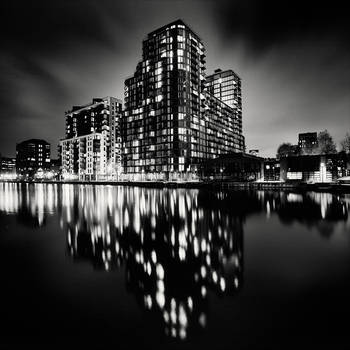The number of vanishing points in an image has a significant effect on its appearance. In the case of a central perspective, all parallel lines going into the distance end up at a vanishing point located in the middle of the picture and at the horizon. You need to stand directly in front of your subject and position your camera horizontally (and pointing at the horizon) to take pictures like this. This means that the front wall of the building you are photographing remains parallel to the image sensor plane, which keeps all the parallel lines within the building's façade parallel in your image. Although this type of shoot looks pleasing, it is rather unspectacular, but that really depends on each case.
Two-point perspective, which furnishes an image with two separate vanishing points on the horizon, is equivalent to photographing a building from a corner rather than head-on. Here too, the camera has ti be positioned horizontally, but in this case, only vertical lines appear parallel in the resulting photo. Two-point perspective images have a vivid, dynamic appearance that clearly illustrates the volume of a building but which can also distract the viewer from the finer points of the architecture itself.
Images shot from a worm's eye view or from a bird's eye view usually have three vanishing points. Here, the camera is no longer pointed at the horizon, but instead at an imaginary point above or below it. These types of perspective come into play when conventional camera positions no longer allow you to capture the entire subject without tilting your camera. In this type of image, vertical lines also converge at a point above or below the horizon.
Converging verticals don't bother us when we are walking along a street, due to the close cooperation between our sense of balance and our visual perception. However, things look different when we see converging verticals in two-dimensional images, as our brain immediately signals that something is wrong. If converging verticals approach each other at a mild angle, a picture can create a restless impression, and a depicted building's aesthetics may be compromised. This can confuse the viewer and produce a jarring impression of a building that is sometimes severe enough to make it look as if it's tripping over backwards.
An unwritten rule dictates that architecture photographers generally try to keep vertical lines vertical in their images, especial when shooting a building on its exterior. This helps to avoid unwanted tension and keeps the composition and the appearance of the architecture clear and uncluttered. Images can be either corrected in Photoshop or shot with an expensive tilt-shift lens that allows to correct them as they're being photographed.
But are converging lines always a bad thing? Strongly converging verticals can be used deliberately to add drama or artistic impact to an image — an effect that is often used in photos of skyscrapers or in situations where the photographer is located very close to the building and is shooting almost directly upward.






